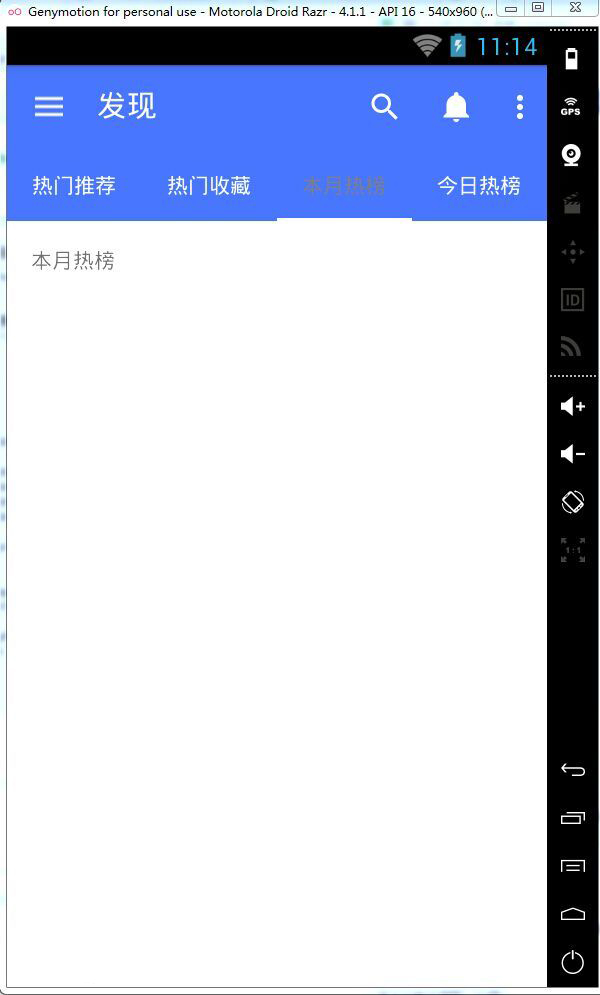
- 学习Android Material Design(RecyclerView代替ListView)
- [Android开发从零开始].13.Table.Layout学习
- Android中访问证书有问题的SSL网页的方法
- Android三种网络通讯方式及Android的网络通讯机制
- Android开发之资源目录assets与res/raw的区别分析
- android获取时间差的方法
- 基于Android本地代码生成器详解
- Android天气预报app改进版
- android 传感器(OnSensorChanged)使用介绍
- Android开发之sqlite3命令行简单使用方法
- 如何判断软件程序是否联网 联网状态提示信息Android实现
- ScrollView滚动条颜色的设置方法
- [Android开发视频教程]02_07_AppWidget的使用(三)
- Android短信验证码自动填充功能
- Android使用文件进行数据存储的方法
- Android游戏开发 自定义手势--输入法手势技术
- 使用Java代码在Android中实现图片裁剪功能
- Android App开发中使用RecyclerView实现Gallery画廊的实例
- Android最新版本开发环境搭建图文教程
- C#之Android手机App开发
- 完整的Android MVP开发之旅
- Android画个时钟玩玩
- android实现Uri获取真实路径转换成File的方法
- [Java4Android]04_Java的变量
- Android简单音乐播放实例
- Android 1.5 1.6 2.0 2.1 2.2 的区别详解
- Android监听Home键和Back键的区别介绍
- Android编程之canvas绘制各种图形(点,直线,弧,圆,椭圆,文字,矩形,多边形,曲线,圆角矩形)
- 九宫图比较常用的多控件布局(GridView)使用介绍
- Android实现固定屏幕显示的方法
Android TabLayout(选项卡布局)简单用法实例分析
作者:佚名 Android开发编辑:admin 更新时间:2022-07-23
本文实例讲述了Android TabLayout(选项卡布局)简单用法。分享给大家供大家参考,具体如下:
我们在应用viewpager的时候,经常会使用TabPageIndicator来与其配合。达到很漂亮的效果。但是TabPageIndicator是第三方的,而且比较老了,当然了现在很多大神都已经开始自己写TabPageIndicator来满足自己的需求,在2015年的google大会上,google发布了新的Android Support Design库,里面包含了几个新的控件,其中就有一个TabLayout,它就可以完成TabPageIndicator的效果,而且还是官方的,最好的是它可以兼容到2.2以上版本,包括2.2。下面我就举一个简单的例子来使用它。
这里使用的 android studio进行开发的,所以引用TabLayout很简单,只要在build.gradle中加入compile 'com.android.support:design:22.2.0'即可。
这个使用是我在仿 知乎 的时候使用。所以页面就和知乎很像了
fragment_find.xml
<LinearLayout xmlns:android="http://schemas.android.com/apk/res/android"
android:layout_width="match_parent"
android:layout_height="match_parent"
xmlns:app="http://schemas.android.com/apk/res-auto"
android:orientation="vertical">
<android.support.design.widget.TabLayout
android:id="@+id/tab_FindFragment_title"
android:layout_width="match_parent"
android:layout_height="wrap_content"
android:background="@color/titleBlue"
app:tabIndicatorColor="@color/white"
app:tabSelectedTextColor="@color/gray"
app:tabTextColor="@color/white"
/>
<android.support.v4.view.ViewPager
android:id="@+id/vp_FindFragment_pager"
android:layout_width="fill_parent"
android:layout_height="0dp"
android:layout_weight="1"
/>
</LinearLayout>
这里面没有什么特别的,就是添加了一个TabLayout和Viewpager作为上下的布局。其中
app:tabIndicatorColor="@color/white" // 下方滚动的下划线颜色 app:tabSelectedTextColor="@color/gray" // tab被选中后,文字的颜色 app:tabTextColor="@color/white" // tab默认的文字颜色
Find_tab_Adapter.java 它是viewpager的Adapter,因为这里面我每个栏目下,都会有一些列表,所以采用list<View>的方式,在里面切换layout不太适合,所以我采用了List<Fragment>来直接加载多个fragment
package com.example.cg.myzhihu.Adapters;
import android.support.v4.app.Fragment;
import android.support.v4.app.FragmentManager;
import android.support.v4.app.FragmentPagerAdapter;
import java.util.List;
/**
* Created by cg on 2015/9/26.
*/
public class Find_tab_Adapter extends FragmentPagerAdapter {
private List<Fragment> list_fragment; //fragment列表
private List<String> list_Title; //tab名的列表
public Find_tab_Adapter(FragmentManager fm,List<Fragment> list_fragment,List<String> list_Title) {
super(fm);
this.list_fragment = list_fragment;
this.list_Title = list_Title;
}
@Override
public Fragment getItem(int position) {
return list_fragment.get(position);
}
@Override
public int getCount() {
return list_Title.size();
}
//此方法用来显示tab上的名字
@Override
public CharSequence getPageTitle(int position) {
return list_Title.get(position % list_Title.size());
}
}
FindFragment.java这个的说法,全在标注里面了
package com.example.cg.myzhihu;
import android.os.Bundle;
import android.support.design.widget.TabLayout;
import android.support.v4.app.Fragment;
import android.support.v4.app.FragmentPagerAdapter;
import android.support.v4.view.ViewPager;
import android.view.LayoutInflater;
import android.view.View;
import android.view.ViewGroup;
import com.example.cg.myzhihu.Adapters.Find_tab_Adapter;
import java.util.ArrayList;
import java.util.List;
/**
* 发现页面
*/
public class FindFragment extends Fragment {
private TabLayout tab_FindFragment_title; //定义TabLayout
private ViewPager vp_FindFragment_pager; //定义viewPager
private FragmentPagerAdapter fAdapter; //定义adapter
private List<Fragment> list_fragment; //定义要装fragment的列表
private List<String> list_title; //tab名称列表
private Find_hotRecommendFragment hotRecommendFragment; //热门推荐fragment
private Find_hotCollectionFragment hotCollectionFragment; //热门收藏fragment
private Find_hotMonthFragment hotMonthFragment; //本月热榜fragment
private Find_hotToday hotToday; //今日热榜fragment
@Override
public View onCreateView(LayoutInflater inflater, ViewGroup container,
Bundle savedInstanceState) {
View view = inflater.inflate(R.layout.fragment_find, container, false);
initControls(view);
return view;
}
/**
* 初始化各控件
* @param view
*/
private void initControls(View view) {
tab_FindFragment_title = (TabLayout)view.findViewById(R.id.tab_FindFragment_title);
vp_FindFragment_pager = (ViewPager)view.findViewById(R.id.vp_FindFragment_pager);
//初始化各fragment
hotRecommendFragment = new Find_hotRecommendFragment();
hotCollectionFragment = new Find_hotCollectionFragment();
hotMonthFragment = new Find_hotMonthFragment();
hotToday = new Find_hotToday();
//将fragment装进列表中
list_fragment = new ArrayList<>();
list_fragment.add(hotRecommendFragment);
list_fragment.add(hotCollectionFragment);
list_fragment.add(hotMonthFragment);
list_fragment.add(hotToday);
//将名称加载tab名字列表,正常情况下,我们应该在values/arrays.xml中进行定义然后调用
list_title = new ArrayList<>();
list_title.add("热门推荐");
list_title.add("热门收藏");
list_title.add("本月热榜");
list_title.add("今日热榜");
//设置TabLayout的模式
tab_FindFragment_title.setTabMode(TabLayout.MODE_FIXED);
//为TabLayout添加tab名称
tab_FindFragment_title.addTab(tab_FindFragment_title.newTab().setText(list_title.get(0)));
tab_FindFragment_title.addTab(tab_FindFragment_title.newTab().setText(list_title.get(1)));
tab_FindFragment_title.addTab(tab_FindFragment_title.newTab().setText(list_title.get(2)));
tab_FindFragment_title.addTab(tab_FindFragment_title.newTab().setText(list_title.get(3)));
fAdapter = new Find_tab_Adapter(getActivity().getSupportFragmentManager(),list_fragment,list_title);
//viewpager加载adapter
vp_FindFragment_pager.setAdapter(fAdapter);
//tab_FindFragment_title.setViewPager(vp_FindFragment_pager);
//TabLayout加载viewpager
tab_FindFragment_title.setupWithViewPager(vp_FindFragment_pager);
//tab_FindFragment_title.set
}
}
效果图,不太会做成动态的:

希望本文所述对大家Android程序设计有所帮助。
- android自定义toast(widget开发)示例
- Android GPS定位测试(附效果图和示例)
- Android仿UC浏览器左右上下滚动功能
- Android 模拟器的使用详细介绍
- Android实现类似360,QQ管家那样的悬浮窗
- Android XML数据解析简单示例
- Android开发中Activity创建跳转及传值的方法